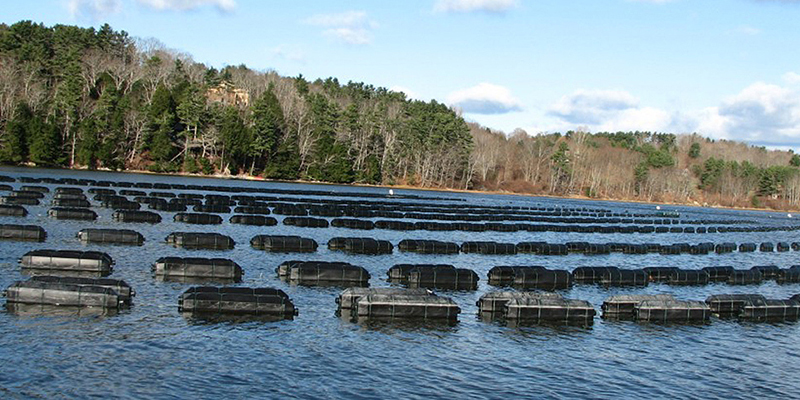“I’ll put it to you this way: If someone has oysters or clams and they can’t sell ‘em, they should just quit!” says Dale Parsons, owner of Parsons Seafood in Tuckerton, N.J.
A fifth-generation oyster and clam business operator, Parsons has seen the industry evolve over the years. Some of the current boom can be attributed to re-openings after the pandemic shutdowns, says Parsons.
“It’s beyond what anyone would have predicted. The vacationers have extra money to spend, so what else can they do but go on vacations and spend money? Right now, it’s crazy busy.”
U.S. seafood prices increased by around 11 percent in the 12 months through early July from the previous period, according to NielsenIQ. With restaurants, seafood markets, and tourism all coming back to life, and consumers’ taste for oysters seemingly insatiable, prices have been stable or higher, with East Coast operations returning to a pre-covid pricing structure.
“Prices are up. Demand is stronger than it’s even been.” And to think, adds Parsons, “Twenty years ago, nobody thought oyster farming was a thing!”
Parsons — whose company mostly wholesales to distributors and only sells to a few select restaurants — says his model is based on large volumes, and lower prices. “My oysters are not the $4 hipster oyster brand, adds Parsons. “I’m like the happy hour oyster guy.” While boutique oysters can get ~$1.50-$2 per oyster, Parsons typically wholesales for about 50 cents apiece, and 65 cents for retail.
In some parts of the East Coast, volume producers are earning 60-70 cents per oyster, and $1 each for smaller sizes. In other places, such as Cape Cod, growers who sell to dealers are earning 45-55 cents per piece.
“Markets are slamming,” agrees Bob Rheault, executive director of the East Coast Shellfish Growers Association, which represents over 1,500 shellfish farmers from Maine to Florida. He says spring markets are now winding down.
“Historically, spring markets have been robust, because they run out.” Yet, Rheault says, the past year qualifies as highly unusual. “A lot of people got vaxxed and booked a reservation at their favorite restaurant, after not eating out for a year. So there is pent-up demand.”
Yet, on the other hand, Rheault says he wonders about beloved restaurants and markets that did not manage to make it through the shutdowns. “My enduring question is: how many of our wonderful customers have bit the dust for good? That’s a huge question in my mind.”
For oyster growers, says Rheault, “it’s incredibly patchy. The states that are just becoming engaged in aquaculture, like North Carolina and South Carolina for instance, have yet to saturate their markets and they just slammed it.” In states with larger aquaculture production, like Maine, Rhode Island, and Virginia, “we all saw a lot of extra products in the markets” during the shutdowns. Early on, adds Rheault, “some big producers cut prices right off the bat and are now seeing they don’t have any [oysters], and are kicking themselves.”
This past year, many growers pivoted to online and social media-focused models, says Rheault, “but it wasn’t without challenges.” The coordination, work, and time it takes to ship out smaller sized boxes, to the slower delivery times and responding to hundreds of customers, instead of just preparing a pallet for wholesale, it was a massive adjustment for businesses making the shift.
“But they did get a retail price for it, so there is a silver lining,” acknowledges Rheault. “The ones who did that worked their butts off!”
In Maine, where lobsters often get the limelight, oysters are sizzling away, with the help of new and unique marketing efforts. In mid-June, the Maine Aquaculture Association launched The Maine Oyster Trail, a guide that features 75 oyster-focused or adjacent businesses in the state.
“One of the farmers on the trail told us they received three inquiries for farm tours within the first week of launch,” says Afton Vigue of the Maine Aquaculture Association. “What we’re seeing is that people are looking for unique, authentic and immersive experiences… and that’s exactly what the Maine Oyster Trail provides.” Vigue says the new Maine Oyster Trail was inspired by the popularity of the Maine Beer Trail, and she views this type of initiative as an opportunity to grow Maine’s agritourism and aquatourism sectors in unison.
There are signs of recovery from the height of the pandemic when volumes were down by 30 percent or more in some states. Many growers were forced to cut prices to dealers to stay afloat. Some relief efforts helped keep the industry in business, while preserving habitat, says Rheault.
One such initiative, the Supporting Oyster Aquaculture and Restoration program led by the Nature Conservancy and Pew Charitable Trusts, thrust $2 million into a fund that supported growers from seven states, many along the U.S. East Coast.
The Nature Conservancy set goals at the start of the program, including: “benefitting 100 shellfish companies, supporting over 200 jobs, and purchasing 5 million oysters for deployment on at least 20 restoration sites.” So far, 3.43 million oysters have been purchased. And the cumulative amount under contract from growers is valued at $1.57 million, according to Rob Jones, Global Lead of Aquaculture at the Nature Conservancy.
Dale Parsons participated in the program and says one challenge was that the 260,000 oysters planted in southern Barnegat Bay, N.J., were preyed upon by stingrays.
“The cownose rays will decimate acres and acres of oysters overnight,” says Parsons, who hopes future restoration initiatives will utilize a method he says is more successful, which involves deploying clusters of shells, instead of individual shells, donated by restaurants or hatcheries. “Those shells will eventually turn into clumps of oysters, and those clusters are fairly ray resistant.”
Planting single oysters is a risk, but the plan was to put out larger ones that are able to resist predation. With the possibility that global warming will continue to extend the range of predators like rays, the industry will have to continue to adapt to changing conditions.
Another challenge of oyster restoration programs is limiting the introduction of pathogens and hitchhiking species when oysters are moved from farms to restoration sites.
“The presence of known pathogens in some growing areas and lack of restoration sites in proximity to growing areas in some states limited the ability of some growers to participate in the program,” says Jones. “This was particularly the case in Maine and Massachusetts.” Monitoring the results of restoration sites will be done one year from deployment, and it appears that the SOAR program will continue in some capacity.
Overall, the SOAR program has been largely successful at achieving its intended goals, adds Jones. The Nature Conservancy conducted a socioeconomic survey of growers participating in the program to judge how impactful the SOAR program has been. “Two-thirds of participating farmers responded that SOAR was ‘very beneficial’ to sustain their businesses through the covid-19 crisis, [while] 92 percent of farmers reported that they would participate in a SOAR purchase program in the future,” according to the conservancy.
Other efforts, including Parson’s own reef recovery program, which makes use of thousands of yards of shells a year that get placed into southern Barnegat Bay and Great Bay to help create reef habitat, is the largest shell recycling program in New Jersey. Restoration efforts all along the east coast are addressing rising seas, climate change, habitat creation, and resilience.
“I do it by choice, as a long-term sustainability effort for generation six,” says Parsons. “If I can provide a stream of production in some unique way, I’m gonna do it — it’s called being a bayman.”
The cumulative news on Northeast oysters is positive, although surges in demand create their own challenges.
“At the beginning [of the pandemic] I was predicting a wave of exits and consolidations, and I just haven’t seen that,” adds Rheault. And there are labor shortages. “Labor has always been a challenge,” adds Rheault. “I don’t think that’s changed.” However, there are other unknowns.
“A number of hatcheries said seed sales are down,” says Rheault, “and gear orders were down.” To stay alive, some growers had to dramatically reduce expenses or delay expansion plans. “I expect there will be some supply constraints.”
That’s already the case in Maine.
“Many farmers have had trouble keeping up with demand and have had to turn down some customers in order to not deplete their inventory,” says Afton Vigue. “Others have announced that they are sold out for the foreseeable future. I think what we’re seeing is a big jump in demand, coupled with a lag in industry growth caused by the pandemic. We are hopeful that this year’s strong demand will help make up for last season’s losses, but as with most other sectors, it will take some more time before a full recovery has been made.”
For RheauIt, sometimes it is simple.
“I go online to Open Table to judge the market. From that, we’re back, at least in terms of booked seating,” he said. In another sign of good news, the 45th annual Milford, Conn., Oyster Festival — a musical and oyster-centered event in mid-August — is back on, after being canceled last year. Milford once supported a major oyster fishery, and organizers say 30,000 oysters will be served at the event this summer.







